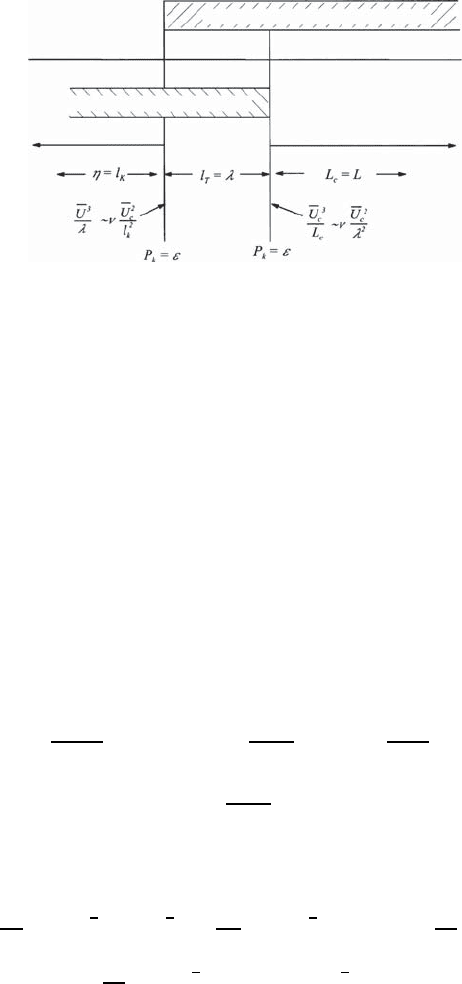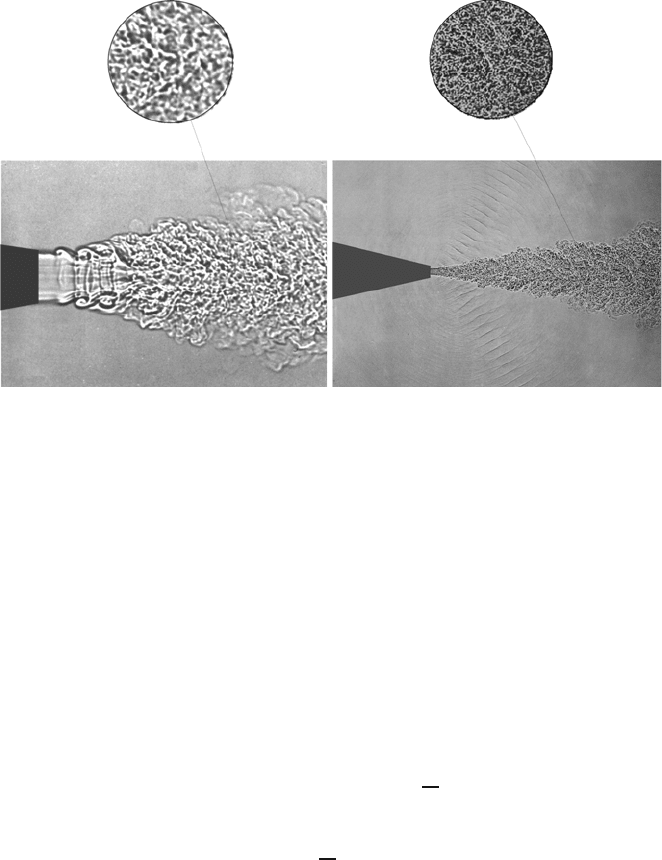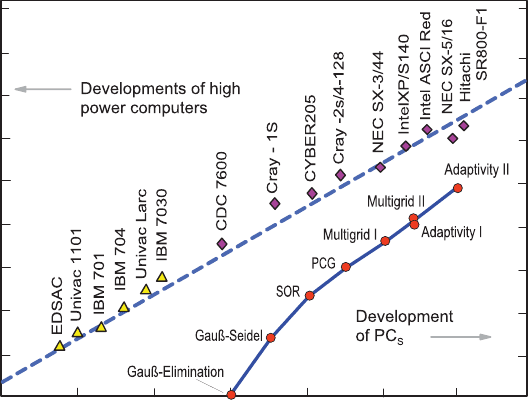Durst F. Fluid Mechanics: An Introduction to the Theory of Fluid Flows
Подождите немного. Документ загружается.


18.6 Scales of Turbulent Flows 553
and the dissipation of turbulent kinetic energy as
k
= µ
∂u
j
∂x
i
∂u
j
∂x
i
(18.117)
the equation for the turbulent kinetic energy can be written in the following
way:
¯ρ
U
i
∂k
∂x
i
= −
∂D
j
∂x
j
+ P
k
−
k
, (18.118)
where k =(1/2
u
2
j
) was introduced, i.e. k =1/2(u
2
1
+ u
2
2
+ u
2
3
). The mean
transport of turbulent kinetic energy is kept “in balance” by the diffusion,
production and dissipation of turbulent kinetic energy at a point in the flow.
Earlier, it was shown that in the equation for the energy of the mean flow
the viscous dissipation, caused by the mean flow field, when compared with
the production term of the turbulent kinetic energy, can be neglected. This
is not the case for the turbulent dissipation in the above equation for the
turbulent kinetic energy, i.e.
k
cannot be neglected with respect to P
k
.This
can, on the other hand, be shown through the following order of magnitude
considerations:
P
k
k
∼
¯ρu
2
c
U
c
l
2
c
L
c
µu
2
c
=
U
c
L
c
ν
l
c
L
c
2
= Re
l
c
L
c
2
, (18.119)
where l
c
/L
c
is the ratio of a characteristic length scale of the considered
turbulence to a length scale characterizing the mean flow. For the ratio l
c
/L
c
,
the following relationship holds in general:
l
c
L
c
= Re
−m
, (18.120)
where m =1/2 can be set, i.e. in the equation for the turbulent kinetic energy
the viscous dissipation cannot be neglected. It is an essential part of (18.118),
describing the transport of turbulent kinetic energy.
18.6 Characteristic Scales of Length, Velocity
and Time of Turbulent Flows
In the preceding sections, order of magnitude considerations were made in
which scales of length, velocity and time of turbulent flows were employed.
So, for the characterization of the mean flow field, a characteristic mean
velocity
U
c
, a characterizing length L
c
and a time scale t
c
were introduced.
Here, L
c
is of the order of the dimensions of the total flow extension, i.e. for
internal flows L
c
has the linear cross-section dimension of the flow channel or
pipe where the fluid flows. The area-averaged or the time-averaged velocity

554 18 Turbulent Flows
of the flow field can be introduced as the characteristic mean velocity. For
the characteristic time, t
c
, the following ratio holds:
t
c
=
L
c
U
c
. (18.121)
If one considers the turbulent velocity fluctuations that occur superimposed
on the mean flow field, it is easy to see that the integral time-scale of the tur-
bulence, introduced in Sect. 18.3, always has to be of the order of magnitude
of the characteristic time scale of the mean flow field, i.e. the largest vortices
that the turbulent part of a flow field possesses have time scales which cor-
respond to those of the mean flow field. Generally, the following relationship
holds:
I
t
≤ t
c
=
L
c
U
c
. (18.122)
Following a suggestion of Kolmogorov, so-called micro-scales can be
introduced to characterize the turbulent flow field:
l
K
= Kolmogorov’s length scale,
u
k
= Kolmogorov’s velocity scale,
τ
k
=(l
K
/u
K
) = Kolmogorov’s time scale.
The length, velocity and time scales introduced by Kolmogorov are deter-
mined in such a way that they characterize that part of the spectrum of the
turbulent velocity fluctuations in which the energy production of the turbu-
lent vortices is equal to the dissipation. Thus, assuming isotropic turbulence,
one can introduce:
≈ P ≈
u
3
K
l
K
for the relationship for production, (18.123)
≈ ν
u
2
K
l
2
K
for the relationship for dissipation. (18.124)
From these results, we can deduce:
u
6
K
=
2
l
2
K
=
3
l
6
K
ν
3
or (18.125)
1=
l
4
K
ν
3
; l
K
=
ν
3
1
4
. (18.126)
From the equality of the terms for production and dissipation, it follows that:
u
K
=
ν
l
K
and thus u
K
=(ν)
1
4
. (18.127)
For the Kolmogorov time scale, the following expression results:
τ
K
=
ν
1
2
. (18.128)

18.6 Scales of Turbulent Flows 555
The Reynolds number resulting on the basis of the above-introduced micro-
length scale and micro-velocity scale is:
Re
K
=
l
K
u
K
ν
=1. (18.129)
The characteristic turbulent eddy quantities, determined by Kolmogorov’s
scales of turbulence, are those that represent the viscous effects which damp
the turbulent velocity fluctuations. These smallest eddies are assumed to
convert the kinetic energy of turbulence into heat. Because of these charac-
teristic properties, the following definitions are available in the literature for
the smallest scales of turbulence:
Kolmogrov’s scales = micro-scales = viscous eddy scales:
l
K
=
ν
3
1
4
; u
K
=(ν)
1
4
; τ
K
=
ν
1
2
. (18.130)
From these scales, characterizing the smallest vortices of a turbulent flow,
the Taylor micro-scale has to be distinguished, which is defined as follows:
τ
T
=
l
T
u
T
=
l
T
U
c
. (18.131)
The extensions of the different scales can perhaps best be illustrated in
schematic form; see Fig. 18.12, which shows that the Taylor micro-scale de-
fines an eddy size which is located between the smallest viscous eddies and
the large eddies having quantities of the dimension of the geometric extension
of the mean flow. Taking this into account, it can be shown that the following
hold:
U
3
c
L
c
= ν
U
2
c
l
2
T
;
l
T
L
c
=
1
Re
1
2
= Re
−
1
2
, (18.132)
where Re =(U
c
L
c
)/ν:
Considering that the following holds:
λ
T
= l
K
U
c
u
c
(18.133)
then inserting this relationship into the equation for
l
T
L
C
and taking into
account
l
K
u
K
ν
= 1, a further important relationship follows from the above
derivations:
l
T
L
c
=
l
K
l
T
2
; l
T
= L
c
l
2
k
. (18.134)
The different length scales of turbulence have proven to be very useful in
formulations of turbulence models, which are summarized in the subsequent
sections. The presentations to follow were chosen such that they are suitable
for introduction into turbulence modeling. More detailed descriptions can be

556 18 Turbulent Flows
Range of turbulence production
Range of dissipation of turbulence
Large length scales
Small length scales
Fig. 18.12 Length scales of turbulence and contributions to production and
dissipation
taken from the available specialized literature on turbulence modeling, given
in the list of references at the end of this chapter.
The above derivations indicate the differences in the structure of turbulent
flows at small and high Reynolds numbers. For flows with the same inte-
gral dimensions (see Fig. 18.12), the flow at a large Reynolds number proves
to be “micro-structured,” i.e. the smallest eddies have small dimensions,
whereas for the small Reynolds number the flow appears “macro-structured.”
The Taylor length scale proves always to be larger than the Kolmogorov
micro length, and the difference between the two becomes larger with in-
creasing Reynolds number. From the above relationships, one can compute
l
T
/l
K
=(Re)
1/4
. For a Reynolds number of approximately Re =10
4
, l
T
is
approximately 10 times larger than l
K
(Fig. 18.13).
In order to characterize the complex nature of turbulent flows, the
following Reynolds numbers are often employed:
Re
K
=
l
K
U
K
ν
=1,Re
K,c
=
l
K
U
c
ν
,Re
λ
=
l
T
U
c
ν
, (18.135)
Re
L
=
L
c
U
c
ν
= Re. (18.136)
Moreover, for the relationships of the characteristic length scales, the
following expression holds:
l
K
L
c
= Re
−
3
4
L
= Re
−
3
2
λ
,
λ
T
L
c
= Re
−
1
2
L
= Re
−1
λ
=
l
K
l
T
2
,
l
K
l
T
= Re
−
1
4
L
= Re
−1
η
= Re
−
1
2
λ
. (18.137)
These relationships are often employed when considering turbulent flows,
in order to carry out order of magnitude considerations regarding the
characteristic properties of turbulence.

18.7 Turbulence Models 557
(a) (b)
Fig. 18.13 (a) Micro-structure of the turbulence of small Reynolds numbers and
(b) micro-structure of the turbulence of higher Reynolds numbers
18.7 Turbulence Models
18.7.1 General Considerations
When limiting oneself to considerations of the components of mean velocity
and the moments of turbulent fluctuation quantities, as far as the solutions
of fluid mechanical problems are concerned, there is the possibility of solv-
ing flow problems theoretically: instead of the Navier–Stokes equations, the
Reynolds equations are solved. In order to derive the latter set of partial
differential equations, the instantaneous velocity
ˆ
U
j
(x
i
,t) was replaced in
Sect. 18.2 by the sum of the local mean velocity
U
j
(x
i
) and the local fluctu-
ation velocity u
i
(x
i
,t), i.e. in Sect. 18.2, it was shown that the following can
be set:
ˆ
U
j
= U
j
+ u
j
. (18.138)
In Sect. 18.3, it was shown moreover that the introduction of this relation-
ships into the continuity equation and the Navier–Stokes equations results,
after time-averaging all terms in the equations, in a new system of equations
which has to be solved numerically for the flow problems to be investigated.
The derivations again yield, for ρ = constant, four differential equations:

558 18 Turbulent Flows
Continuity equation for j =1, 2, 3:
∂U
i
∂x
i
=0. (18.139)
Reynolds equation:
¯ρ
U
i
∂U
j
∂x
i
= −
∂
¯
P
∂x
j
+
∂
∂x
i
µ
∂
U
j
∂x
i
− ¯ρu
i
u
j
+¯ρg
j
. (18.140)
The derivations have led, however, to the introduction of new unknowns given
by the following fourth-order tensor:
u
i
u
j
=
⎛
⎝
u
2
1
u
1
u
2
u
1
u
3
u
2
u
1
u
2
2
u
2
u
3
u
3
u
1
u
3
u
2
u
2
3
⎞
⎠
, (18.141)
which can be referred to as “Reynolds momentum transport terms,” but are
often also called Reynolds stress terms.
The introduction of additional unknowns into the basic equations of
fluid mechanics lead to a non-closed system of equations and this re-
quires additional information in order to obtain solutions from (18.139) and
(18.140). This required information, often formulated as additional differen-
tial equations, represents general statements on the interrelation between the
Reynolds momentum transport terms and the mean velocity field. The deriva-
tions of these additional differential equations require additional physical
insights into the turbulent velocity correlations (18.141) and their dependence
on the mean flow field. The development of model considerations for these
unknown terms is an important field of research in fluid mechanics. Consider-
ations of this kind are carried out in the form of turbulence models by various
research groups. The basics of such models are described in the following sec-
tions only in an introductory manner. Further insight into this important
sub-domain of fluid mechanics shows that the introduction of turbulence
models serves to derive “closing assumptions” for the Reynolds equations.
Succeeding in formulating additional equations, i.e. producing physically ap-
propriate turbulence models, a new system of equations results, based on the
Reynolds equations, which can be employed to solve turbulent flow problems.
The formulation of physically appropriate additional equations, i.e. to
provide physically appropriate information for the correlations
u
i
u
j
for the
treatment of the Reynolds equations, can partly be realized by hypothetical
assumptions, as was often done in the past when setting up turbulence mod-
els. There is, however, the possibility to obtain the information required for
turbulence models by means of detailed experimental investigations in differ-
ent turbulent flows. For this purpose, local measurements of the instantaneous
velocity of turbulent flows are necessary. Such measurements can be achieved
with the help of hot wire and hot film anemometry and also laser Doppler
anemometry. Those measuring techniques provide the necessary resolution

18.7 Turbulence Models 559
with respect to time and space variations of the flow, to carry out all the mea-
surements required for detailed turbulence modeling. The measuring methods
can be considered to be fully developed, so that the required measurements
can be carried out without serious application problems. Such measurements
contribute considerably to deepening the comprehension of the physics of tur-
bulence and make it possible to introduce additional information in the form
of new equations to yield numerical solution procedures for turbulent flows.
For measurements in wall boundary layers, hot wire and hot film anemome-
ters have been employed with great success for determining the mean velocity
U
i
and the fluctuation quantities u
i
u
j
(see Sect. 18.8). Flows of this kind
can be investigated reliably with hot wire anemometers because of their
characteristic properties. However, in the case of very thin boundary lay-
ers, inherent disturbances may occur which are caused by the introduced
measuring sensors. By special shaping of the employed measuring sensors,
these disturbances and the resulting measurement errors can be kept low.
Most measuring methods, requiring the introduction of measuring sensors
into flows, measure the flow velocity only indirectly, i.e. with most measuring
instruments physical quantities are recorded which are functions of the flow
velocity. Unfortunately, the measuring quantities are often also functions
of the properties of the state of the flow medium. The latter have to be
known and have to be adapted already when calibrating the measuring
method, in order to make the interpretation of the measured data possible
in terms of velocity. When fluctuations of the fluid properties occur during
the attempted velocity measurements, e.g. in two-phase flows, flows with
chemical reactions etc., they have to be known to be able to determine
reliably the required velocity values.
The above-mentioned difficulties in the employment of indirect measuring
techniques for flow velocities, such as hot wire and hot film anemometry,
have led to the development of the laser Doppler technique, which measures
flow velocities directly. By measuring the time which a particle needs to
flow through an interference pattern with a well-defined fringe distance, the
velocity of light-scattering particles can be determined. Such measurements
can be carried out locally and do not depend on the unknown thermodynamic
properties of the flow fluid. Measurements are possible in one- and two-phase
flows, and also in combustion systems and in the atmosphere. The measuring
technique can moreover be employed in particle-loaded flows, i.e. in media as
they often occur in practice. Its application requires, however, optical access
to the measuring point and transparency of the flow medium. In this respect
the employment of laser Doppler anemometry is limited, but its application
makes the determination of flow velocities possible in a large number of flows
that are not accessible to other measuring methods.
Due to considerable developments in applied mathematics over the last
few decades, new methods to solve numerically systems of partial differen-
tial equations, such as those describing fluid flows, have appeared. These

560 18 Turbulent Flows
10
10
10
10
10
10
10
10
0
2
4
6
8
10
12
14
1940
1950
1970
1960 1980
1990
2000
Computer power (Flop/s)
16
18
10
10
2010
10
0
10
2
10
4
10
5
10
3
10
1
10
6
Fig. 18.14 Increase in computing and computer power in the employment of
mathematical methods and of high-speed computers
developments were supported by an increase in computing power, as shown
in Fig. 18.14.
Considering also the increased performance of high-performance computer
systems, as also indicated in Fig. 18.14, it becomes understandable that it is
possible nowadays to obtain direct numerical solutions of turbulent flows at
least at small Reynolds numbers. Such solutions lead to important insights
that can be employed for the development of refined turbulence models. In
the following section, it is shown how the knowledge gained by experimental
and numerical investigations of turbulent flows can be used to formulate
turbulence models for the unknown Reynolds momentum transport terms.
Whereas in the past turbulence model developments had to be carried out
without such knowledge, numerically obtained information on the behavior
of turbulent flows is nowadays available.
18.7.2 General Considerations Concerning Eddy
Viscosity Models
In Sect. 18.5, the basic equations of fluid mechanics were employed, i.e. the
continuity equation, the Navier–Stokes equation and the mechanical en-
ergy equation, in order to introduce into them time-averaged quantities of

18.7 Turbulence Models 561
turbulent property fluctuations. After time averaging of the resulting equa-
tions and taking into account ∂/∂t(
···) = 0, the following relationships could
be derived:
• Continuity equations:
–Meanflowfield:
∂
U
i
∂x
i
=0. (18.142)
– Fluctuating flow field:
∂u
i
∂x
i
=0. (18.143)
• Navier–Stokes equations (for g
j
=0)
–Meanflowfield:
¯ρ
U
i
∂U
j
∂x
i
= −
∂
¯
P
∂x
j
+
∂
∂x
i
µ
∂
U
j
∂x
i
− ¯ρu
i
u
j
. (18.144)
– Fluctuating flow field:
¯ρ
U
i
∂
1
2
u
j
u
j
∂x
i
= −¯ρu
i
u
j
∂U
j
∂x
i
−
∂
∂x
i
u
i
¯ρu
j
u
j
2
+ p
−µ
∂u
j
∂x
i
∂u
j
∂x
i
+ µ
∂
1
2
u
j
u
j
∂x
i
∂x
i
. (18.145)
• Thermal energy equation:
– Mean temperature field:
ρc
p
U
i
∂
¯
T
∂x
i
=
∂
∂x
i
λ
∂
¯
T
∂x
i
− ρc
p
u
i
T
. (18.146)
– Fluctuating temperature field:
U
i
∂
∂x
i
1
2
T
2
= −
∂
∂x
i
1
2
T
2
u
i
− a
∂
∂x
i
1
2
T
2
−
u
i
T
∂
¯
T
∂x
i
− a
∂T
∂x
i
2
(18.147)
with a = λ/ρc
p
.
Regarding the solutions of laminar flow problems, it had been possible, by
employing the continuity and the Navier–Stokes equations, to solve a number
of problems analytically, i.e. the set of differential equations that was available
constituted a closed system of partial differential equations for these cases.
1
When considering the corresponding system of equations for turbulent flows,
e.g. the continuity equation and the momentum equation for the mean flow
1
By a closed differential system, one understands a system in which the number of
unknown variables and the number of equations available are equal.

562 18 Turbulent Flows
field, it can be seen from the above statements that the system of equations
is not closed. There appear six additional unknown quantities, namely the
correlations of the velocity fluctuations u
i
and u
j
, i.e. the elements of the
following tensor:
u
i
u
j
=
⎛
⎝
u
2
1
u
1
u
2
u
1
u
3
u
2
u
1
u
2
2
u
2
u
3
u
3
u
1
u
3
u
2
u
2
3
⎞
⎠
. (18.148)
This shows that the derivations of the time-averaged equations, generally
holding for turbulent flows, have led to a closing problem which has to be
solved before solutions of the above equations for turbulent flows can be
sought. The development of suitable closing assumptions is tackled in flow
research by turbulence model developments:
• By turbulence modeling, one understands the development of closing as-
sumptions, which are formulated in the form of additional equations and
which are employed in addition to the averaged continuity and Navier–
Stokes equations, i.e. the Reynolds equations, for the solution of flow
problems.
Such closing assumptions should make use of experimentally or numeri-
cally obtained information, so that soundly based assumptions for the prop-
erties of turbulent flow quantities can be employed as additional equations,
needed for numerical solutions of turbulent flow problems.
In the literature, a large number of different turbulence models have been
proposed, developed and employed for flow problem solutions, based on the
Reynolds equation for turbulent flows. They can be classified as follows. All
the following models have one thing in common, according to a suggestion of
Boussinesq: they set the transport mechanism of turbulent velocity fluctua-
tions equal to the transport of molecules in an isotropic Newtonian fluid, i.e.
it is assumed that the following relationship holds:
¯ρ
u
i
u
j
= −¯ρν
T
∂
U
j
∂x
i
+
∂
U
i
∂x
j
, (18.149)
ν
T
is defined as the eddy viscosity, which has to be regarded as an unknown
quantity, and it represents a property of the turbulent flow and not the fluid.
It is the task of the above eddy viscosity models, often also called “first-order
closure models,” to provide good model assumptions for the eddy viscosity ν
T
.
To reach this goal, the considerations below based on characteristic velocity
and length scales need to be considered:
ρu
2
c
∼ ρν
T
u
c
l
c
; ν
T
∼ u
c
l
c
, (18.150)
i.e. defining equation of the eddy viscosity:
ν
T
=
−
u
i
u
j
∂
U
j
∂x
i
+
∂
U
i
∂x
j
. (18.151)
